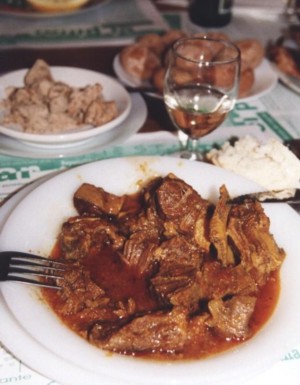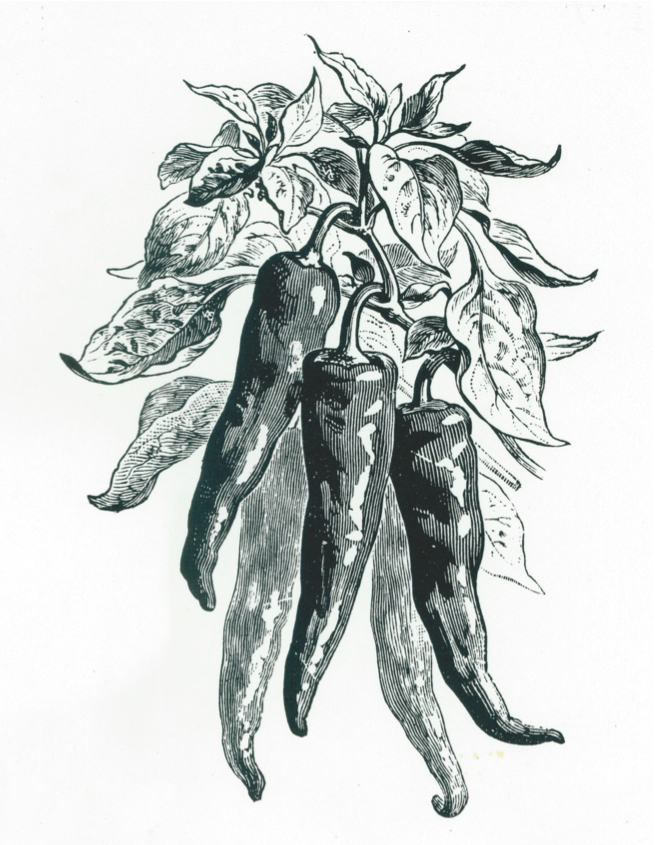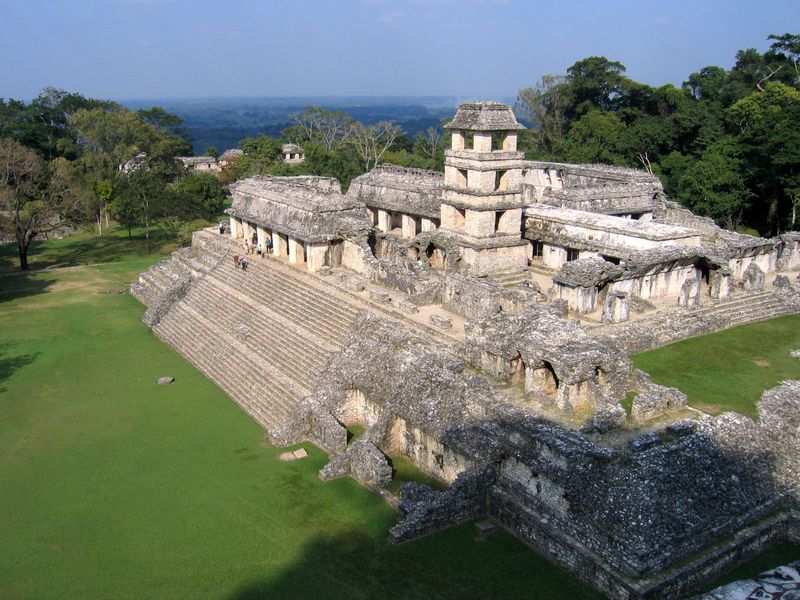
Cabo means “cape” in Spanish, and it is part of the name given to two cities at the end of the Baja California peninsula, separated by 20 miles of beaches and resorts. Cabo San Lucas is referred to as Cabo, whereas San Jose del Cabo is referred to as San Jose. Cabo is the one most tourists and people think of; the party town with the nightclubs and all the action. San Jose del Cabo is a charming town, without all the action like nightclubs, but has a unique charm of its own. San Jose del Cabo is where a lot of locals live and is more traditional Mexican than Cabo San Lucas, but we refer to both of these twin cities together as Los Cabos.
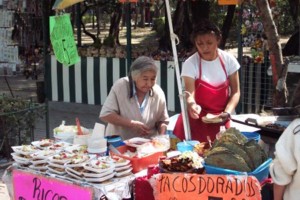
Serving Up Great Tacos in Los Cabos
I lived in Baja California Sur for two years before moving to Cabo last year; doing so has brought me one step closer to burning the roof of my mouth off. Baja California is known for fish tacos, and don’t get me wrong, I love fish tacos–almost as much as I love lobster or shrimp tacos. But there is so much more to the food of Los Cabos than just fish tacos. This area is home to ferocious foods that will make your tongue explode and your eyes water. You will breathe fire after you try these unique dishes, which we call enchiloso (fiery).

Feasting Aboard a Catamaran
The hardest thing about living in Mexico is that the napkins are very small, and excessive use of salsa with will require at least a few dozen napkins. I should know, I am the self-proclaimed emperor of enchiloso. I might not deserve this title, but I have discovered the hidden treasures in the taco stands and open-air restaurants of Los Cabos, from marlin quesadillas at Surf Taco on the main drag of Cabo San Lucas, to home-cooked meals of baby goat in the most remote locations in Los Cabos. Here, you never know what you might discover. I discovered that I needed to find some better napkins or at least a handkerchief.
Sometimes the tequila and cerveza can be dangerous south of the border, but a diet of endless Mexican food can cure any disease. I’m just a gringo, but I’ve challenged many a local in unofficial enchiloso eating; though victorious, I have acknowledged defeat to the empty napkin dispenser at least a hundred times. Never before have I savored such unusual delicacies as these special Cabo dishes. The homemade seafood and chicken stews are like heaven on earth–or like purgatory when you run out of cold Coronas. Cabo will transform you into a new person as soon as you arrive.

A “Small” Family Dinner
Just remember to check the napkin dispenser or your take-out box before you hit the scenic land’s end beaches between San Jose and San Lucas. Los Cabos is referred to by many locals as Cabo San Locos, and it will make you crazy. But it will also lead you toward the road less traveled and the most tasty unusual foods in Baja, especially if you search long and hard enough. Discover the infinite possibilities here at the end of the earth, where heaven has blessed us with fire and the waves are the largest napkin on the planet.
San Jose del Cabo Chicken Stew
The secret to this recipe is using the freshest possible ingredients. The more you stir, especially in the beginning, the better this recipe will turn out.
1/2 cup vegetable oil
1 large onion, sliced as thinly as possible
1/2 cup water
3 jalapenos, chopped
12 green olives
2 cloves garlic, minced
4 cups tomatoes, chopped,
3 tablespoons capers
3 ribs celery, chopped
1/2 teaspoon chipotle
3 bay leaves
2 teaspoons dried leaf oregano, crumbled
1 teaspoon salt
1/2 teaspoon pepper
10 ounces sliced mushrooms
6 boneless chicken breasts
Add the vegetable oil to a large sauce pan over medium heat. Add the onion and cook, stirring until it softens. Stir in all remaining ingredients except the mushrooms and chicken breasts. Bring the mixture to a boil, then reduce the heat and let simmer, uncovered, for 35 minutes. Place the chicken in a single layer in skillet, skin side up. Cover and cook over medium-low heat for 30 minutes. Add mushrooms, cover and cook for another 15 minutes until chicken is done.
Yield: 6 servings
Heat Scale: Medium
Marlin Quesadillas
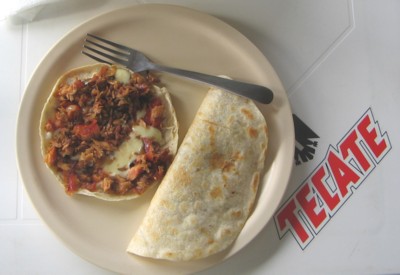
Make sure to keep an eye on your quesadillas while they’re cooking; you don’t want to overcook the cheese, which should ooze gradually into the fish to create a mixed and delicious flavor. You can substitute any type of fish for marlin.
1 tablespoon butter
2 12-inch tortillas (the largest kind you can find, usually considered big enough for burritos)
1/3 cup Monterey jack cheese, shredded
1/3 cup cheddar cheese, shredded
1/2 large tomato, chopped
2 teaspoons diced onion
2 teaspoons diced jalapeno peppers
1/4 pound smoked marlin, cut into thin narrow strips
1/4 teaspoon cilantro
1/4 teaspoon chipotle powder
In a large cast-iron skillet or griddle, melt the butter. Place one of the tortillas in the pan, and quickly sprinkle the cheese in the center portion of the tortilla, leaving about an inch or so uncovered on the outer edges. Spread the tomato, onion, peppers, and the delicious smoked marlin strips over the melting cheese. Sprinkle the cilantro, chipotle, (and any spices, peppers, salts, or other such seasonings you want to experiment with) on the fresh marlin. Next, place the second tortilla over the quesadilla. Cook for 2 minutes, allowing the bottom tortilla to reach a golden-brown hue.
Successfully flipping the hot quesadilla over to the other side without losing all the contents is a risky maneuver. I recommend using a spatula and proceeding with caution: slow and meticulous is better than trying to show off for your friends, family members, or any pets in the kitchen. I usually use my hands and I usually regret that strategy.
Whatever method you use, as soon as you’ve done that flip, brown the bottom tortilla for another couple of minutes. Once it’s golden and cooked to perfection, take it out of the pan (carefully) and slice it up into four, six, or eight symmetrical pieces. Then serve it with salsa, jalapenos, and any side dishes you desire.
Yield: 2 servings
Heat Scale: Medium
Cabo San Lucas Guacamole with Habanero
This is the most common guacamole in Cabo, and it is the centerpiece of many home-cooked meals. This is traditionally made with a molcajete y mano, a large Mexican mortar and pestle carved from volcanic rock. If you don’t have a molcajete y mano, you can smash the avocados with a fork or potato masher.
2 ripe avocados
1/2 clove garlic
1 roasted jalapeno, stemmed and chopped
2 habanero chiles, roasted, peeled, stemmed and chopped
1 tablespoon chopped cilantro
2 limes
Salt, to taste
For the chips:
12 small fresh corn tortillas, cut into wedges
2 cups corn oil
Salt, to taste
Peel and pit the avocados, then grind them in the molcajete. Add the garlic, chiles and cilantro and keep grinding. Gently squeeze in the lime juice and add salt to taste. Serve with fresh Mexican tortilla chips.
To make the tortilla chips, heat the oil in a large frying pan until it reaches 350 degrees F. Fry the tortilla wedges in batches, cooking each for about 3 minutes, or until they become a nice shade of golden brown. Sprinkle the chips with salt then keep them warm in a 200 degree F. oven.
Yield: 2 cups
Heat Scale: Hot
Cabo Killer Salsa
Don’t take the name lightly. This salsa will make you feel like you’re dying. If it’s too spicy, or you don’t want to risk your life, simply use five habaneros and jalapenos instead of nine.
1 1/2 cup water
1 cup tomato sauce
1/2 cup onion, diced
9 habanero peppers, chopped
9 fresh jalapeno peppers, with seeds, chopped
2 tablespoons white vinegar
1/4 teaspoon sauce from a can of chipotles in adobo
1/4 teaspoon bottled hot sauce
1/4 teaspoon salt
1/2 teaspoon dried minced onion
1/2 teaspoon dried minced garlic
In a small saucepan over medium heat, combine all of the ingredients and stir. Bring the mixture to a boil, then reduce the heat and simmer for about 35-40 minutes. Remove the pan from the heat. Transfer the salsa to a resealable plastic container and refrigerate it overnight.
Yield: About 2 cups
Heat Scale: Extremely hot
Los Cabos Seafood Stew
(Miraflores)

In Cabo, locals often add lobster, scallops, octopus, and even squid into this dish. Oysters and mussels can also be included to create a uniquely Cabo seafood experience.
1/4 cup olive oil
1/2 cup onion, chopped
1/2 cup New Mexico green chiles, chopped
4 jalapenos, chopped
2 habaneros, chopped
2 cloves garlic, finely chopped
1 teaspoon dried basil leaves
1 teaspoon sugar
2 cups white wine
1/2 teaspoon freshly ground black pepper
1 teaspoon orange peel, grated
1 1/2 cups orange juice
1 teaspoon salt
1 teaspoon chipotle pepper
1 teaspoon chopped fresh cilantro
1/2 teaspoon dried Mexican oregano
1 (28-ounce) can plum tomatoes, cut in half
24 clams, scrubbed
1 1/2 pound shelled shrimp
1 pound sea bass, marlin, cod, mahi-mahi or red snapper
6 ounces crab meat
Add the oil to a 6-quart Dutch oven over medium heat. Add the onion, green chiles, jalapenos, habaneros, and garlic and cook until the onion is translucent. Stir in all of the remaining ingredients except the seafood and bring the mixture to a boil. Reduce the heat and simmer uncovered for 15-20 minutes.
Add the clams and continue simmering until the clams open up, 5 to 10 minutes. Discard any clams that have not opened after 10 minutes. Carefully stir in the fish, crabmeat, and shrimp and bring the mixture to a boil again. Reduce the heat and simmer just until the shrimp are pink and the fish flakes easily with a fork, about 4 to 5 minutes. Serve immediately.
Yield: 6 servings
Heat Scale: Hot
Cabrito Stew (Kid Goat Stew)
